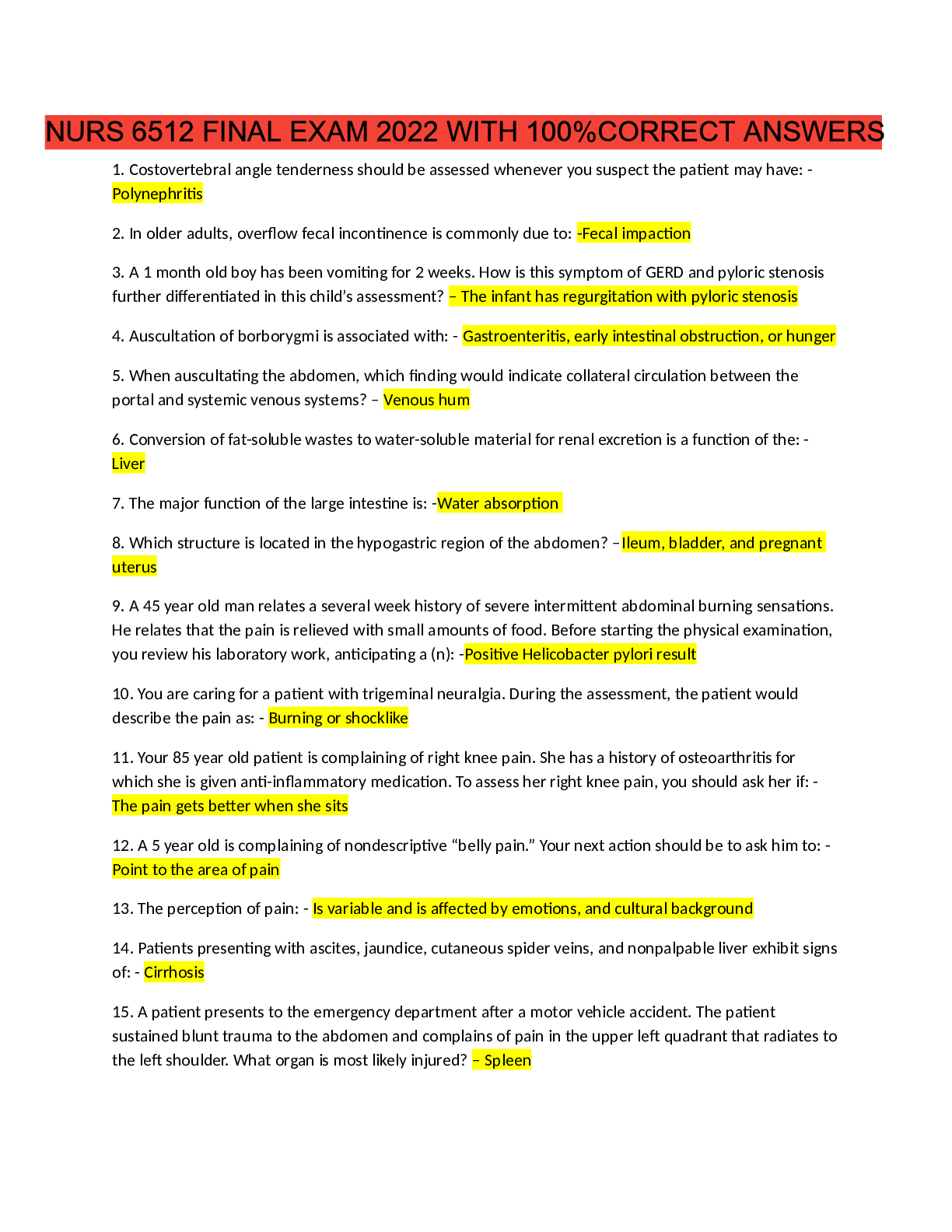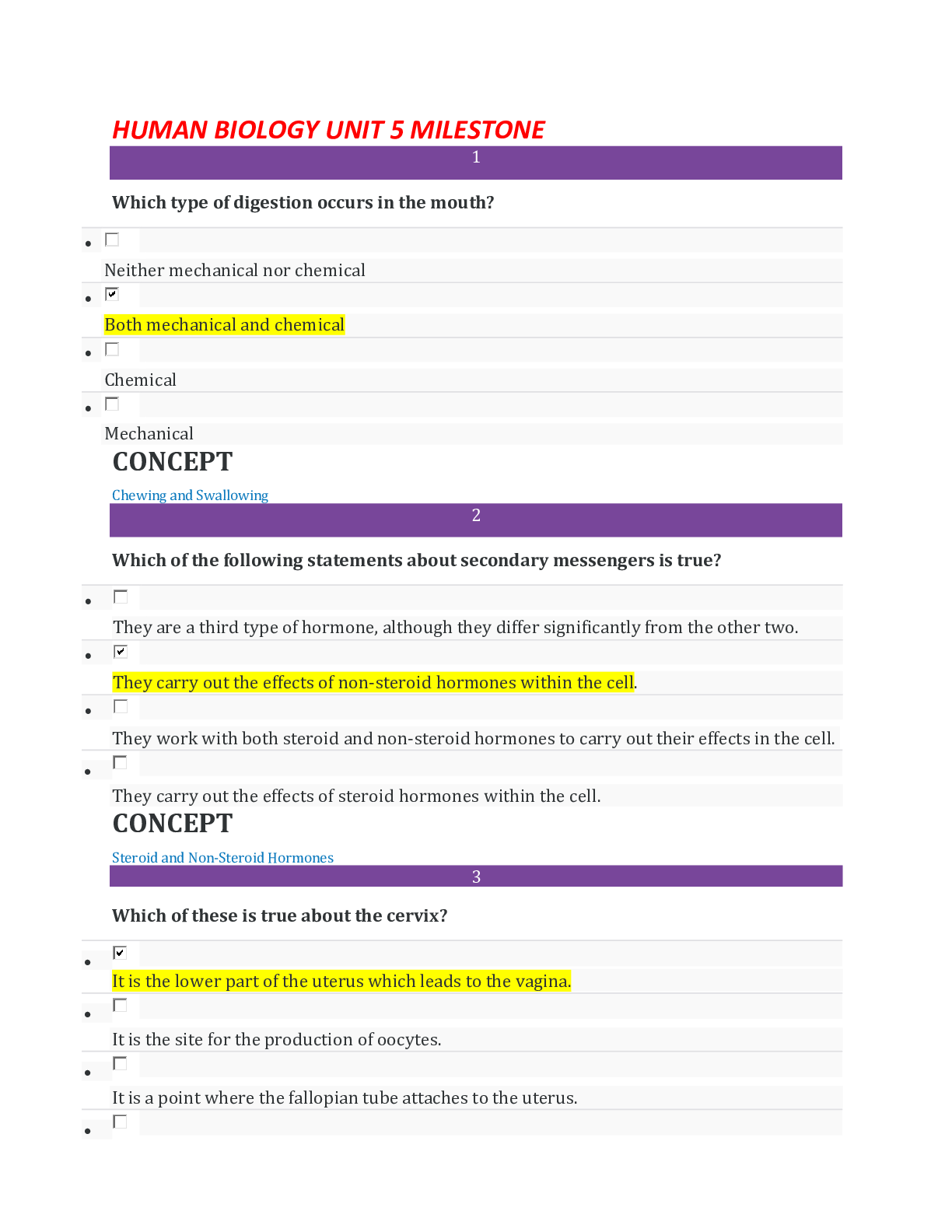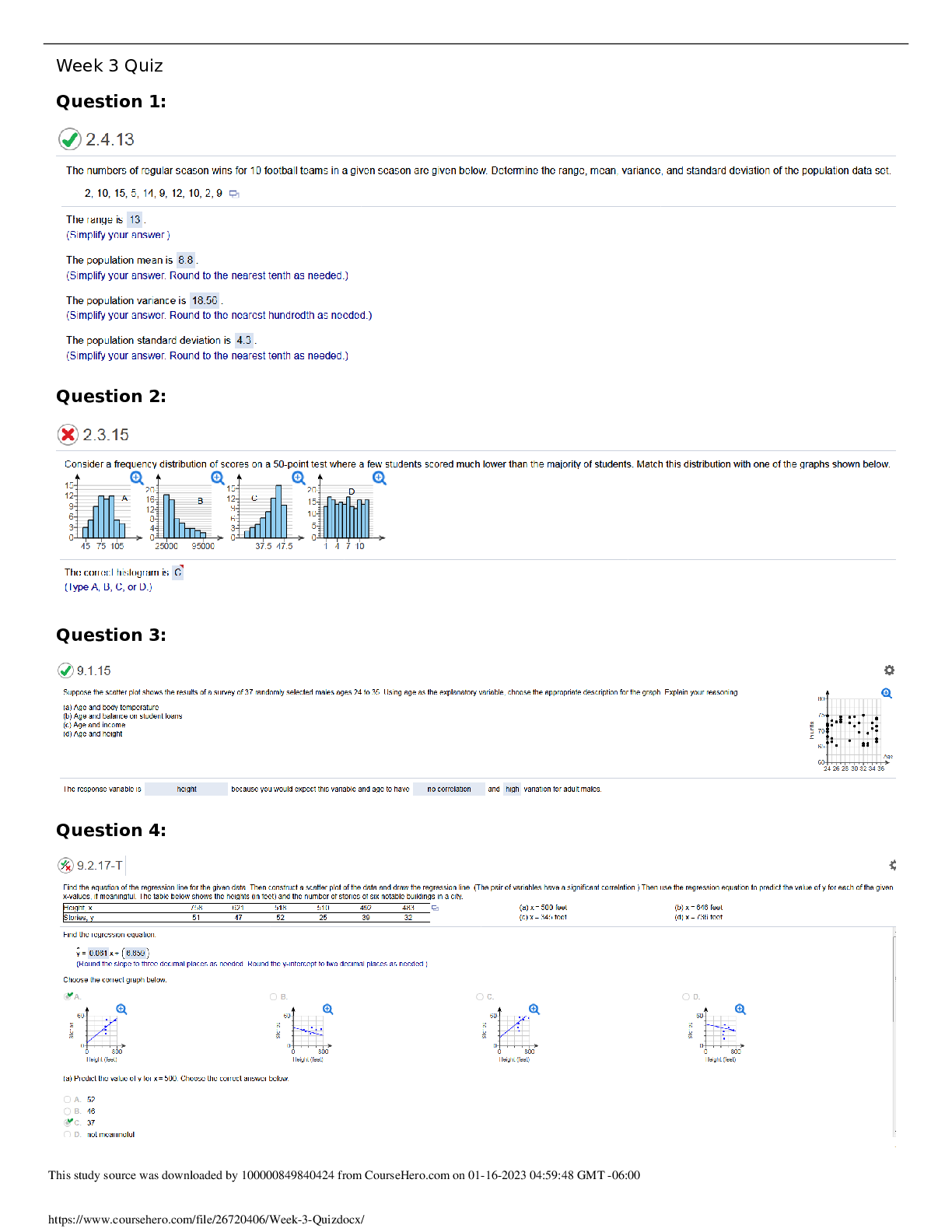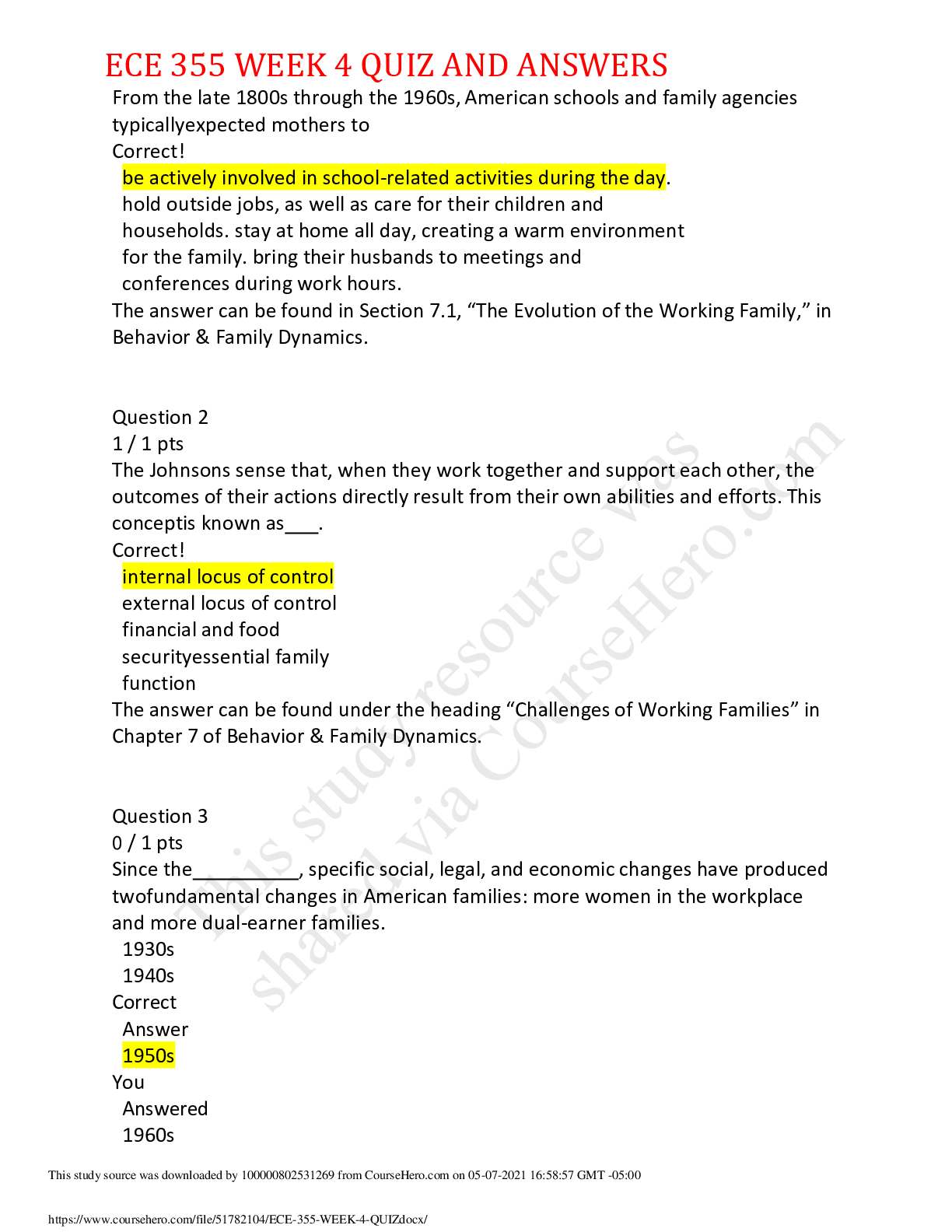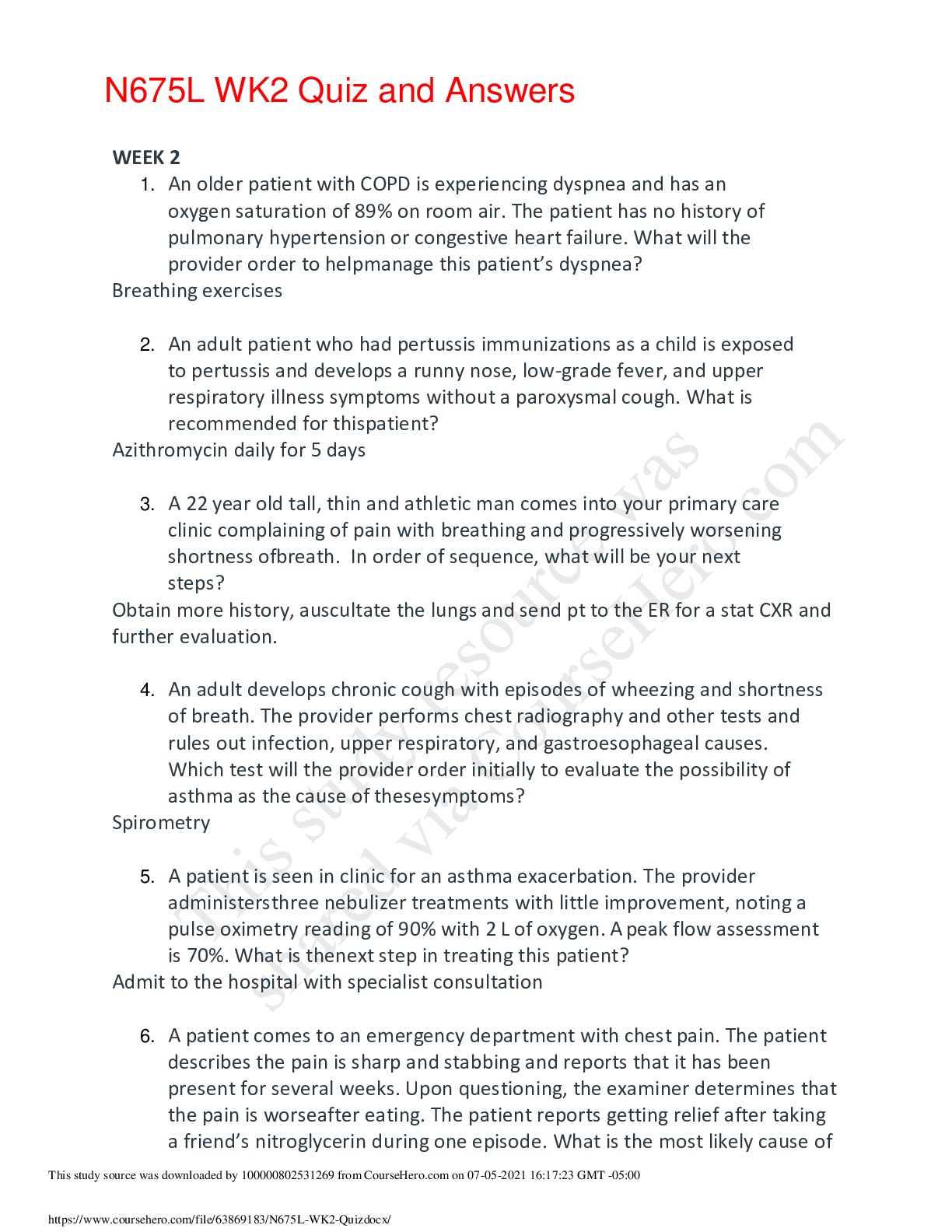Kaplan University: MN 551 Midterm quiz and Answers,100% CORRECT
Document Content and Description Below
Kaplan University: MN 551 Midterm quiz and Answers A nurse practitioner employed in the emergency department admits a patient who has experienced severe frostbite to his hands and toes after becomi... ng lost on a ski trail. The NP recognizes that which of the following phenomena has caused the tissue damage? (Points : 2) Decreased blood viscosity has resulted in interstitial bleeding. Reactive vasodilation has compromised perfusion. Autonomic nervous stimulation has resulted in injury. Decreased blood flow has induced hypoxia. Question 2.2. A 6-year-old boy has been brought to the emergency department by ambulance after his mother discovered that his heart rate was “so fast I couldn't even count it.” The child was determined to be in atrial flutter and his mother is seeking an explanation from the health care team. Which of the following points should underlie an explanation to the mother? (Points : 2) The child is experiencing a reentry rhythm in his right atrium. The resolution of the problem is dependent on spontaneous recovery and is resistant to pacing interventions. The child is likely to have a normal ECG apart from the rapid heart rate. The boy's atria are experiencing abnormal sympathetic stimulation. Question 3.3. A 14-year-old boy has been diagnosed with infectious mononucleosis. Which of the following pathophysiological phenomena is most responsible for his symptoms? (Points : 2) The Epstein-Barr virus (EBV) is lysing many of the boy's neutrophils. Viruses are killing some of his B cells and becoming incorporated into the genomes of others. The EBV inhibits the maturation of white cells within his peripheral lymph nodes. The virus responsible for mononucleosis inhibits the maturation of myeloblasts into promyelocytes. Question 4.4. A patient has suffered damage to his pericardium following a motor vehicle accident. Which of the following consequences should the nurse practitioner be most likely to rule out? (Points : 2) Impaired physical restraint of the left ventricule Increased friction during the contraction/relaxation cycle Reduced protection from infectious organisms Impaired regulation of myocardial contraction Question 5.5. Sputum samples from a patient with pneumonia contain an infective agent that has a peptidoglycan cell wall, expresses endotoxins, replicates readily in broth and on agar, grows in clusters, has pili, and does not stain when exposed to crystal violet. This pneumonia is most likely: (Points : 2) Chlamydial Viral Mycoplasmal Bacterial Question 6.6. A nurse practitioner student is familiarizing herself with the overnight admissions to an acute medical unit of a university hospital. Which of the following patients would the student recognize as being least likely to have a diagnosis of antiphospholipid syndrome in his or her medical history? (Points : 2) A 66-year-old obese male with left-sided hemiplegia secondary to a cerebrovascular accident A 90-year-old female resident of a long-term care facility who has been experiencing transient ischemic attacks A 30-year-old female with a diagnosis of left leg DVT and a pulmonary embolism A 21-year-old male with a diagnosis of cellulitis and suspected endocarditis secondary to intravenous drug use Question 7.7. A number of patients have presented to the emergency department in the last 24 hours with complaints that are preliminarily indicative of myocardial infarction. Which of the following patients is least likely to have an ST-segment myocardial infarction (STEMI)? (Points : 2) A 70-year-old woman who is complaining of shortness of breath and vague chest discomfort A 66-year-old man who has presented with fatigue, nausea and vomiting, and cool, moist skin A 43-year-old man who woke up with substernal pain that is radiating to his neck and jaw A 71-year-old man who has moist skin, fever, and chest pain that is excruciating when he moves but relieved when at rest Question 8.8. A 44-year-old female patient presents to the emergency department with abnormal bleeding and abdominal pain that is later attributed to gallbladder disease. Which of the following diagnoses would the medical team be most justified in suspecting as a cause of the patient's bleeding? (Points : 2) Calcium deficiency Vitamin K deficiency Hemophilia B Idiopathic ITP Question 9.9. A 60-year-old male patient with an acute viral infection is receiving interferon therapy. The nurse practitioner is teaching the family of the patient about the diverse actions of the treatment and the ways that it differs from other anti-infective therapies. Which of the following teaching points should the nurse practitioner exclude? (Points : 2) “Interferon can help your father's unaffected cells adjacent to his infected cells produce antiviral proteins that limit the spread of the infection.” “Interferon can help limit the replication of the virus that's affecting your father.” “Interferon helps your father's body recognize infected cells more effectively.” “Interferon can bolster your father's immune system by stimulating natural killer cells that attack viruses.” Question 10.10. A nurse practitioner employed in a hospitalist notices that a patient is experiencing muscle atrophy following 2 weeks in traction after a motor vehicle accident. Which of the following factors has most likely contributed to the atrophy of the patient's muscle cells? (Points : 2) High levels of insulin and IGF-1 in the patient's blood during immobilization Denervation of the affected muscles during the time of traction A reduction of skeletal muscle use secondary to the traction treatment Reduced oxygen consumption and cellular function that ensures muscle cell survival Question 11.11. A 16-year-old female has been brought to her primary care nurse practitioner by her mother due to the girl's persistent sore throat and malaise. Which of the following facts revealed in the girl's history and examination would lead the nurse practitioner to rule out infectious mononucleosis? (Points : 2) The girl has a temperature of 38.1°C (100.6°F) and has enlarged lymph nodes. Her liver and spleen are both enlarged. Blood work reveals an increased white blood cell count. Chest auscultation reveals crackles in her lower lung fields bilaterally. Question 12.12. A nurse practitioner is providing care for several patients on a medical unit of a hospital. In which of the following patient situations would the nurse practitioner be most likely to rule out hypertension as a contributing factor? (Points : 2) A 61-year-old man who has a heart valve infection and recurrent fever An 81-year-old woman who has had an ischemic stroke and has consequent one-sided weakness A 44-year-old man awaiting a kidney transplant who requires hemodialysis three times per week A 66-year-old woman with poorly controlled angina and consequent limited activity tolerance Question 13.13. A group of researchers has identified that the prevalence of two particular genetic disorders share a statistical correlation. Which of the following statements best conveys the genetic rationale for this situation? (Points : 2) There is likely a cause-and-effect relationship between the two genes responsible. The chromosomes containing each gene are likely closely situated. The genes causing each disorder are likely in the same section of the same chromosome. The disorders likely share the same locus. Question 14.14. A 71-year-old woman is dependent on oxygen therapy and bronchodilators due to her diagnosis of emphysema. Which of the following processes would her care team be most justified in ruling out? (Points : 2) Decreased elastic recoil due to alveolar damage Decreased residual lung volume due to impaired alveolar ventilation Increased anatomic dead space due to reduced tidal volume Increased alveolar dead space due to incorrect intrapleural pressure Question 15.15. A researcher is involved in the production of insulin through recombinant DNA technology. Which of the following statements could the researcher best provide as a rationale for her work? (Points : 2) The gene fragment responsible for insulin production can be isolated and reproduced. Particular bacteria are capable of insulin production. It is possible to reproduce the chromosome responsible for insulin production. Recombination of DNA base pairs can result in a gene that will produce insulin. Question 16.16. Which of the following residents of a long-term care facility is most likely to be exhibiting the signs and symptoms of chronic obstructive pulmonary disease (COPD)? (Points : 2) A 79-year-old lifetime smoker who is complaining of shortness of breath and pain on deep inspiration An 81-year-old smoker who has increased exercise intolerance, a fever, and increased white blood cells An 81-year-old male who has a productive cough and recurrent respiratory infections An 88-year-old female who experiences acute shortness of breath and airway constriction when exposed to tobacco smoke Question 17.17. Which of the following patients on a medical unit of a hospital is most likely to be experiencing health problems that may be attributable to kidney disease? (Points : 2) An 81-year-old female patient with osteoporosis and anemia A 77-year-old patient with urinary retention due to benign prostatic hyperplasia (BPH) A 55-year-old woman with a recent stroke secondary to long-standing hypertension A 60-year-old man with a systemic fungal infection requiring intravenous antibiotics Question 18.18. A 66-year-old obese man with a diagnosis of ischemic heart disease has been diagnosed with heart failure that his care team has characterized as attributable to systolic dysfunction. Which of the following assessment findings is inconsistent with his diagnosis? (Points : 2) His resting blood pressure is normally in the range of 150/90 and an echocardiogram indicates his ejection fraction is 30%. His end-diastolic volume is higher than normal and his resting heart rate is regular and 82 beats per minute. He is presently volume overloaded following several days of intravenous fluid replacement. Ventricular dilation and wall tension are significantly lower than normal. Question 19.19. Which of the following phenomena is most likely occurring during a child's alveolar stage of lung development? (Points : 2) Terminal alveolar sacs are developing and surfactant production is beginning. A single-capillary network exists and the lungs are capable of respiration. The conducting airways are formed, but respiration is not yet possible. Primitive alveoli are formed and the bronchi and bronchioles become much larger. Question 20.20. A nurse practitioner has ordered the measurement of a cardiac patient's electrolyte levels as part of the patient's morning blood work. Which of the following statements best captures the importance of potassium in the normal electrical function of the patient's heart? (Points : 2) Potassium catalyzes the metabolism of ATP, producing the gradient that results in electrical stimulation. Potassium is central to establishing and maintaining the resting membrane potential of cardiac muscle cells. The impermeability of cardiac cell membranes to potassium allows for action potentials achieved by the flow of sodium ions. The reciprocal movement of one potassium ion for one sodium ion across the cell membrane results in the production of an action potential. Question 21.21. Which of the following patients who presented to a walk-in medical clinic is most likely to be diagnosed with a rhinosinusitis rather than a common cold? (Points : 2) A man complaining of general fatigue, a headache, and facial pain with a temperature of 100.9°F A woman presenting with malaise, lethargy, and copious nasal secretions A man with a dry, stuffy nasopharynx, a sore throat, and temperature of 98.9°F A woman complaining of generalized aches who has a hoarse voice and reddened, painful upper airways Question 22.22. A patient with poorly controlled diabetes mellitus presents to the emergency department with suspected ketoacidosis. Which of the following diagnostic results would be most likely to confirm this diagnosis? (Points : 2) Low O2 levels, increased anion gap, base excess High ammonia levels, decreased anion gap, high potassium Increased CO2, increased anion gap, base deficit Decreased CO2, decreased anion gap Question 23.23. A 3-year-old boy has developed croup following a winter cold. His nurse practitioner would recognize that which of the following causative microorganisms and treatments are most likely? (Points : 2) Respiratory syncytial virus; treatment with intubation Parainfluenza virus; treatment with a mist tent and oxygen therapy Haemophilus influenza; treatment with appropriate antibiotics Staphylococcus aureus; treatment with bronchodilators and a mist tent Question 24.24. A 66-year-old female patient has presented to the emergency department because of several months of intermittently bloody stools that has recently become worse. The woman has since been diagnosed with a gastrointestinal bleed secondary to overuse of nonsteroidal anti-inflammatory drugs that she takes for her arthritis. The health care team would realize that which of the following situations is most likely?(Points : 2) The woman has depleted blood volume due to her ongoing blood loss. She will have iron-deficiency anemia due to depletion of iron stores. The patient will be at risk for cardiovascular collapse or shock. She will have delayed reticulocyte release. Question 25.25. A child possesses a trait that is the result of the interaction of two different genes, neither of which could have produced the trait independently. Which of the following explanations best captures the genetic explanation for this? (Points : 2) The trait is an expression of multiple alleles. Epistasis has dictated the phenotypic outcome. The phenomenon is an example of polygenic inheritance. The outcome is the result of the interaction between collaborative genes. Question 26.26. Which target of both chemotherapy and radiation treatment accounts for adverse as well as therapeutic effects? (Points : 2) Cell-surface receptors Circulating hormone levels Blood vessels Rapidly proliferating cells Question 27.27. A patient who has a diagnosis of lung cancer is scheduled to begin radiation treatment. The NP providing pretreatment education is explaining some of the potential unwanted effects of the treatment. Which of the following statements by the nurse is most accurate? (Points : 2) “Some patients experience longer-term irritation of skin adjacent to the treatment site.” “Sometimes you might find that your blood takes longer to clot than normal.” “The changes that you might see are normally irreversible.” “The unwanted effects will be limited to the exposed portions of your skin.” Question 28.28. A 77-year-old female with a diagnosis of chronic obstructive pulmonary disease is experiencing impaired gas exchange and CO2 retention, despite a rapid respiratory rate. Which of the following phenomena would her care team most realistically anticipate? (Points : 2) Arterial blood gas sampling is likely to indicate a pH in the range of 7.45 to 7.55. Her kidneys are likely to reabsorb H+ and secrete HCO3–. Her body may be producing excess metabolic CO2. Her kidneys will adapt with an increase in plasma HCO3– and her pH will decrease. Question 29.29. The nurse practitioner for a cardiology practice is responsible for providing presurgical teaching for patients who are about to undergo a coronary artery bypass graft. Which of the following teaching points best conveys an aspect of the human circulatory system? (Points : 2) “Your blood pressure varies widely between arteries and veins, and between pulmonary and systemic circulation.” “Only around one quarter of your blood is in your heart at any given time.” “Blood pressure and blood volume roughly mimic one another at any given location in the circulatory system.” “Left-sided and right-sided pumping action at each beat of the heart must equal each other to ensure adequate blood distribution.” Question 30.30. As part of his diagnostic workup, a 77-year-old man's nurse practitioner has ordered blood work that includes ferritin levels. The man is very interested in the details of his health care and is unfamiliar with ferritin and its role. He asks his nurse practitioner to explain the significance of it and the rationale for testing it. Which of the following explanations by the nurse practitioner is most accurate? (Points : 2) “Ferritin is the activated and usable form of iron that your red blood cells can use to transport oxygen.” “Ferritin is a stored form of iron that indirectly shows me whether you would benefit from iron pills.” “Ferritin is a protein-iron complex that allows your red blood cells to make use of the iron that you consume in your diet.” “Ferritin is the form of iron that is transported in your blood plasma to the red blood cells that need it.” Question 31.31. A nurse educator is orientating new nurses to a renal unit of a hospital. Which of the following teaching points should the nurse include as part of a review of normal glomerular function? (Points : 2) “Nephrons are delicate structures that cannot endure the high pressure that exists in capillary beds elsewhere in the body.” “Glomerular filtrate is very similar in composition to blood plasma found elsewhere in circulation.” “Dilation of the afferent arteriole allows more blood into the nephron and increases the glomerular filtration rate.” “The glomerulus is located between an arteriole and a venule that work together to regulate blood flow.” Question 32.32. A 77-year-old lifetime smoker has been diagnosed with a tumor in his lung at the site of an old tubercle scarring site, located in a peripheral area of his bronchiolar tissue. What is this patient's most likely diagnosis? (Points : 2) Squamous cell carcinoma Small cell lung cancer Large cell carcinoma Adenocarcinoma Question 33.33. A 51-year-old woman diagnosed with multiple sclerosis (MS) five months prior is distressed that she has had several recent episodes of urinary incontinence. She has asked her nurse practitioner why this is the case. Which of the following statements best captures the facts that would underlie the nurse's response to the patient? (Points : 2) Neurologic diseases like MS often result in flaccid bladder dysfunction. She may be unable to sense her bladder filling as a result of her MS. Lesions of the basal ganglia or extrapyramidal tract associated with MS inhibit detrusor contraction. Pathologic reductions in bladder volume brought on by MS necessitate frequent micturition. Question 34.34. Which of the following individuals are displaying identified risk factors for the development of lower urinary tract obstruction? (Points : 2) A 32-year-old woman who had a healthy delivery of her third child 4 months ago A 68-year-old man who has been diagnosed with benign prostatic hyperplasia (BPH) A 55-year-old man with diabetes who is receiving diuretic medications for the treatment of hypertension A 30-year-old woman who has been diagnosed with gonorrhea A 74-year-old woman who has developed a lower bowel obstruction following several weeks of chronic constipation A 20-year-old man who has spina bifida and consequent impaired mobility Question 35.35. A 29-year-old construction worker got a sliver under his fingernail four days ago. The affected finger is now reddened, painful, swollen, and warm to the touch. Which of the following hematological processes is most likely occurring in response to the infection? (Points : 2) Proliferation of immature neutrophils High circulatory levels of myeloblasts Increased segmented neutrophil production Phagocytosis by myelocytes Question 36.36. A 22-year-old female who adheres to a vegan diet has been diagnosed with iron-deficiency anemia. Which of the following components of her diagnostic blood work would be most likely to necessitate further investigation? (Points : 2) Decreased mean corpuscular volume (MCV) Decreased hemoglobin and hematocrit Microcytic, hypochromic red cells Decreased erythropoietin levels Question 37.37. A formerly normotensive woman, pregnant for the first time, develops hypertension and headaches at 26 weeks' gestation. Her blood pressure is 154/110 mm Hg and she has proteinuria. What other labs should be ordered for her? (Points : 2) Plasma angiotensin I and II and renin Urinary sodium and potassium Platelet count, serum creatinine, and liver enzymes Urinary catecholamines and metabolites Question 38.38. A nurse practitioner is providing prenatal care and education for a first-time expectant mother, 22 weeks' gestation, who has a diagnosis of a sexually transmitted infection. Which of the following statements by the expectant mother demonstrates an adequate understanding of vertical disease transmission and congenital infections? (Points : 2) “Gonorrhea and chlamydia pose the greatest risks of transmission from mother to child.” “I know that my baby will need observation for HIV signs and symptoms in the weeks following my delivery.” “My baby could become infected either across the placenta or during the birth itself.” “Prophylactic immunization will reduce my baby's chance of being born with an illness.” Question 39.39. A 60-year-old man has been diagnosed with renal calculi after repeated episodes of excruciating flank pain in recent weeks. The man states, “I don't know how this could happen to me, since I'm so careful about eating a healthy diet.” What is the most appropriate response to the man's statement? (Points : 2) “Your diet may have played a part in this, but in fact genetics is likely primarily to blame.” “What you eat can influence your risk of stone formation, but many other factors like hormones and your metabolism are involved.” “You likely don't need to change your diet, but now that you have stones in one kidney, you're at very high risk of growing them in the other kidney.” “Your diet might be normally healthy, but high intake of normally beneficial minerals like calcium and magnesium can lead to stones.” Question 40.40. A 7-year-old boy is admitted to the hospital with a suspected diagnosis of lead toxicity. Which of the following assessment findings is most congruent with the patient's diagnosis? (Points : 2) Decreased deep tendon reflexes Hemoglobin 9.9 g/dL Diffuse muscle pain White blood cells (WBC) 11,000/mm3 Question 41.41. A pediatric unit will be receiving from a rural medical outpost a patient transfer of an 8-day-old infant with a suspected congenital renal disorder. Which of the following possibilities is the care team most likely to be able to rule out early? (Points : 2) One of the infant's kidneys may have failed to develop to a normal size. The kidneys may be misshapen and have cysts. The upper or lower poles of the two kidneys may be fused. Renal cell carcinoma may be present. Question 42.42. A 31-year-old woman with a congenital heart defect reports episodes of lightheadedness and syncope, with occasional palpitations. A resting electrocardiogram reveals sinus bradycardia and she is suspected of having sick sinus syndrome. Which of the following diagnostic methods is the best choice to investigate the suspicion? (Points : 2) Signal-averaged ECG Exercise stress testing Electrophysiologic study Holter monitoring Question 43.43. As a result of dehydration, a patient's epithelial cells are producing insufficient amounts of mucus. Consequently, the patient's mucociliary blanket is compromised. Which of the following changes would a care provider most reasonably anticipate as a direct result of this change? (Points : 2) Impaired function of the patient's cilia Decreased levels of oxygen saturation Increased amounts of bacteria in the lungs Increased carbon dioxide levels Question 44.44. An 87-year-old male resident of an assisted living facility has been consistently continent of urine until the last several weeks. Which of the following actions by the care providers at the facility is the most likely priority? (Points : 2) Performing a physical examination and history to determine the exact cause and character of the incontinence Providing patient education focusing on the fact that occasional incontinence is a normal, age- related change Teaching the resident about protective pads, collection devices, and medications that may be effective Showing the resident the correct technique for exercises to improve bladder, sphincter, and pelvic floor tone Question 45.45. A patient who presented with shortness of breath and difficulty climbing stairs has been diagnosed with pulmonary fibrosis, a disease characterized by scarring of the alveoli. What would her care team anticipate when observing her breathing? (Points : 2) Rapid, deep breaths Wheezing breaths Short, shallow breaths Pursed-lip breaths [Show More]
Last updated: 1 year ago
Preview 1 out of 27 pages
Instant download
.png)
Buy this document to get the full access instantly
Instant Download Access after purchase
Add to cartInstant download
Reviews( 0 )
Document information
Connected school, study & course
About the document
Uploaded On
Sep 30, 2021
Number of pages
27
Written in
Additional information
This document has been written for:
Uploaded
Sep 30, 2021
Downloads
0
Views
27




